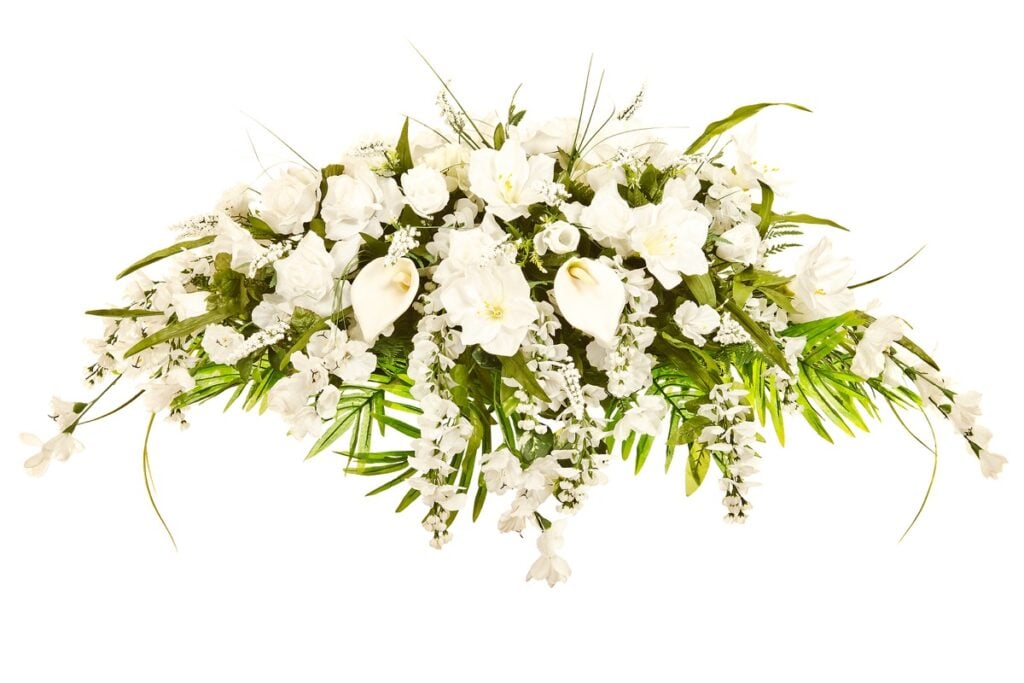Funeral flowers hold significant meanings in various cultures and religions, reflecting traditions, beliefs, and respect for the deceased. Incorporating culturally appropriate flowers can make the funeral service more meaningful and respectful of the deceased’s heritage. Here’s a breakdown of cultural traditions involving funeral flowers:
Asian Funeral Flowers
- Chinese Traditions
White chrysanthemums are the most common funeral flowers in Chinese culture, symbolizing grief, lamentation, and tribute to the deceased. Bright or red flowers are avoided as they are associated with celebration and happiness. - Japanese Traditions
White and yellow chrysanthemums are traditional for Japanese funerals, representing mourning and respect. Simplicity and elegance are key in Japanese flower arrangements, reflecting cultural values. - Korean Traditions
In Korean funerals, white flowers such as lilies or chrysanthemums are common. These flowers express purity and mourning. Floral arrangements are often understated, with a focus on solemnity.
Hindu Funeral Flowers
- Marigolds and Jasmine
Marigolds and jasmine are frequently used in Hindu funerals. Marigolds are strung into garlands and placed around the deceased or as part of the altar, symbolizing purity and liberation of the soul. Jasmine represents peace and the eternal bond with the divine. - No Artificial Flowers
Hindu traditions discourage the use of artificial flowers, emphasizing natural blooms as an offering to honor the cycle of life.
Buddhist Funeral Flowers
- White Flowers
White is the color of mourning in Buddhist culture. White flowers, especially lilies, chrysanthemums, and carnations, are commonly used. These flowers are often presented simply, reflecting the Buddhist value of humility. - No Extravagance
In keeping with Buddhist principles, flowers should not be overly extravagant or ostentatious, focusing instead on simplicity and respect.
Christian Funeral Flowers
- Symbolism of Crosses and Lilies
Flowers such as lilies and roses are widely used in Christian funerals, symbolizing resurrection, peace, and eternal life. Cross-shaped arrangements are common in Christian services to honor faith. - Regional Variations
Different Christian denominations and regions may influence floral choices. For example, in Southern United States funerals, white roses and magnolias are often prominent.
Islamic Funeral Flowers
- Minimal Use of Flowers
In Islamic traditions, flowers are not a major part of funerals. However, some families may choose to include simple floral arrangements to express sympathy. White flowers are preferred due to their association with purity. - Focus on Prayers
Instead of elaborate floral displays, Islamic funerals emphasize prayers and simplicity in arrangements, reflecting the faith’s focus on modesty.
Jewish Funeral Flowers
- Limited Use of Flowers
Flowers are generally not a traditional part of Jewish funerals. Instead, families may request donations to charity in honor of the deceased. In some modern funerals, simple arrangements, often white, may be included for personal preference.
African Funeral Flowers
- Cultural Variability
Funeral traditions vary widely across African countries and cultures. In some regions, vibrant and colorful flowers are used to celebrate the life of the deceased, while in others, simpler arrangements are preferred. - Symbolic Colors
Colors such as white and gold may hold symbolic meaning, representing purity and the afterlife, and are sometimes reflected in floral arrangements.
Western Funeral Flowers
- Europe
In many European countries, specific flowers hold symbolic meanings. For example, in Greece, white flowers such as lilies or carnations are common, while in Italy, white and yellow chrysanthemums are reserved for funerals. - North America
Western funerals often use a mix of lilies, roses, and carnations in various arrangements such as sprays, wreaths, or bouquets. Cultural influences may also shape floral preferences based on the deceased’s heritage.
Latin American Funeral Flowers
- Bright and Vibrant Flowers
In Latin American cultures, bright flowers such as marigolds are often used, especially during Día de los Muertos (Day of the Dead) celebrations. These flowers represent the vibrancy of life and serve as a connection between the living and the dead. - Religious Influence
In predominantly Catholic regions, flowers such as lilies and roses are often chosen to symbolize faith and eternal life.
By considering these cultural traditions when selecting funeral flowers, families can honor the deceased’s heritage while creating a service that resonates deeply with attendees. Always consult with family members or a cultural expert if unsure about specific customs.

